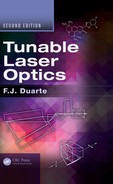Contents
Chapter 1 Introduction to Lasers
1.3 Excitation Mechanisms and Rate Equations
1.3.2 Dynamics of Multiple-Level System
1.3.3 Transition Probabilities and Cross Sections
1.4 The Schrödinger Equation and Semiconductor Lasers
1.4.1 A Heuristic Introduction to the Schrödinger Equation
1.4.2 The Schrödinger Equation Via dirac’s Notation
1.4.3 The Time-Independent Schrödinger Equation
1.5 Introduction to Laser Resonators and Laser Cavities
2.2 Dirac’s Notation in Optics
2.3.2 Geometry of The N-Slit Interferometer
2.3.3 N-Slit Interferometer Experiment
2.5 Positive and Negative Refraction
2.7 The Cavity Linewidth Equation
2.7.1 Introduction to Angular Dispersion
Chapter 3 The Uncertainty Principle in Optics
3.1 Approximate Derivation of the Uncertainty Principle
3.1.1 The Wave Character of Particles
3.1.2 The Diffraction Identity and the Uncertainty Principle
3.1.3 Alternative Versions of the Uncertainty Principle
3.2 Applications of the Uncertainty Principle in Optics
3.2.2 Beam Divergence and Astronomy
3.3 The Interferometric Equation and the Uncertainty Principle
Chapter 4 The Physics of Multiple- Prism Optics
4.2 Generalized Multiple-Prism Dispersion
4.2.1 Double-Pass Generalized Multiple-Prism Dispersion
4.2.2 Multiple Return-Pass Generalized Multiple-Prism Dispersion
4.3 Multiple-Prism Dispersion Linewidth Narrowing
4.3.1 Mechanics of Linewidth Narrowing in Optically Pumped Pulsed Laser Oscillators
4.3.2 Design of Zero-Dispersion Multiple-Prism Beam Expanders
4.4 Dispersion of Amici, or Compound, Prisms
4.5 Multiple-Prism Dispersion and Pulse Compression
4.6 Applications of Multiple-Prism Arrays
5.3 Polarization and Reflection
5.5.1 Transmission Efficiency in Multiple-Prism Arrays
5.5.2 Induced Polarization in a Double-Prism Beam Expander
5.6 Double-Refraction Polarizers
5.7 Intensity Control of Laser Beams Using Polarization
5.8.1 Birefringent Polarization Rotators
5.8.2 Broadband Prismatic Polarization Rotators
Chapter 6 Laser Beam Propagation Matrices
6.2.1 Properties of ABCD Matrices
6.2.3 The Astronomical Telescope
6.2.5 Multiple-Prism Beam Expanders
6.2.7 Single Return-Pass Beam Divergence
6.2.8 Multiple Return-Pass Beam Divergence
Chapter 7 Narrow-Linewidth Tunable Laser Oscillators
7.2 Transverse and Longitudinal Modes
7.2.1 Transverse Mode Structure
7.2.2 Longitudinal Mode Emission
7.3 Tunable Laser Oscillator Architectures
7.3.1 Tunable Laser Oscillators Without Intracavity Beam Expansion
7.3.2 Tunable Laser Oscillators With Intracavity Beam Expansion
7.3.3 Widely Tunable Narrow-Linewidth External Cavity Semiconductor Lasers
7.3.4 Distributed Feedback Lasers
7.4 Wavelength Tuning Techniques
7.4.1 Prismatic Tuning Techniques
7.4.2 Diffractive Tuning Techniques
7.4.3 Synchronous Tuning Techniques
7.4.5 Interferometric Tuning Techniques
7.4.6 Longitudinal Tuning Techniques for Laser Microcavities
7.6 Design of Efficient Narrow-Linewidth Tunable Laser Oscillators
7.6.1 Useful Axioms for the Design of Narrow- Linewidth Tunable Laser Oscillators
7.7 Narrow-Linewidth Oscillator-Amplifiers
7.7.1 Laser-Pumped Narrow-Linewidth Oscillator-Amplifiers
7.7.2 Narrow-Linewidth MO Forced Oscillators
8.1.1 Introduction to Nonlinear Polarization
8.2 Generation of Frequency Harmonics
8.2.1 Second Harmonic and Sum-Frequency Generation
8.2.2 Difference-Frequency Generation and Optical Parametric Oscillation
8.2.3 The Refractive Index as a Function of Intensity
Chapter 9 Lasers and Their Emission Characteristics
9.2.1 Pulsed Molecular Gas Lasers
9.2.2 Pulsed Atomic Metal Vapor Lasers
9.3.1 Pulsed Organic Dye Lasers
9.3.1.1 Solid-State Tunable Organic Lasers
9.4.1 Ionic Solid-State Lasers
9.4.2 Transition Metal Solid-State Lasers
9.4.4 Diode Laser-Pumped Fiber Lasers
9.4.5 Optical Parametric Oscillators
9.5.1 Tunable Quantum Cascade Lasers
9.5.2 Tunable Quantum Dot Lasers
Chapter 10 The N-Slit Laser Interferometer Optical Architecture and Applications
10.2 Optical Architecture of the NSLI
10.2.1 Beam Propagation in the N SLI
10.3 An Interferometric Computer
10.4 Secure Interferometric Communications in Free Space
10.4.1 Very Large N Slis for Secure Interferometric Communications in Free Space
10.5.1 Digital Laser Micromeasurements
10.5.2 Light Modulation Measurements
10.5.3 Wavelength Meter and Broadband Interferograms
11.2.1 The Sagnac Interferometer
11.2.2 The Mach-Xehnder Interferometer
11.2.3 The Michelson Interferometer
11.3 Multiple-Beam Interferometers
11.3.1 The Hanbury Brown–Twiss Interferometer
11.3.2 The Fabry–Pérot interferometer
11.3.3 Design of Fabry–Pérot Etalons
11.4 Coherent and Semicoherent Interferograms
11.5 Interferometric Wavelength Meters
11.5.1 Fabry–Pérot Wavelength Meters
12.2.2 Diffraction Grating Spectrometers
12.3 Dispersive Wavelength Meters
Chapter 13 Physical Constants and Optical Quantities
13.1 Fundamental Physical Constants
13.3 Units of Optical Quantities
13.4 Dispersion Constants of Optical Materials
